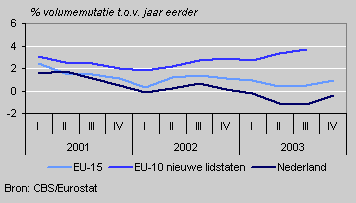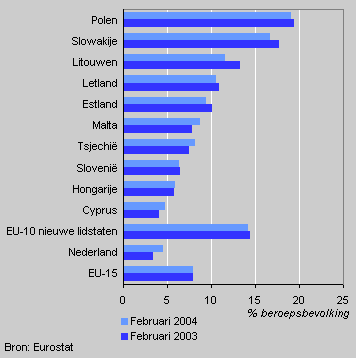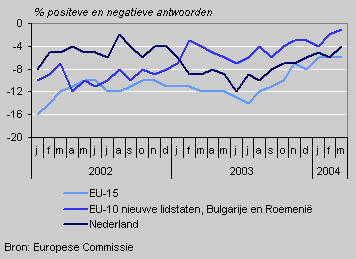Economic growth higher in new member countries than in EU-15

On 1 May this year ten countries will join the European Union (EU), bringing the number of member countries to 25. The enlargement will increase the gross domestic product (GDP) by 437 billion euro to 9,600 billion euro.
Higher economic growth in accession countries
In the ten new countries economic growth was significantly higher in the last ten years than in the present fifteen EU countries. In the third quarter of 2003, the difference in favour of the accession countries was as much as 3.2 percent points. In the Baltic states in particular, economic growth was substantial, with growth rates of over 5 percent. In Malta and Cyprus, growth was more moderate. Poland, the largest economy of the new countries, had a growth rate of just over 3 percent.
Gross domestic product

Higher unemployment
Unemployment is higher on the whole in the ten new EU countries than the average for the present fifteen EU countries. The harmonised unemployment rate was 14.2 percent for the new countries in February 2004, compared with 8.0 in the EU-15. Unemployment was highest in Poland and Slovakia. In Poland in particular unemployment has risen quickly in recent years: by nearly 6 percent points in the period 1999-2003.
Unemployment

More varied production structure
There are substantial differences in employment by sectors of industry between the present and the accession countries. In the new countries 17 percent of jobs were in agriculture, forestry and fishery in 2002, while this was only 4 percent of jobs in the present member countries. In the new EU countries 32 percent of jobs are in trade, transport and business services, compared with 41 percent in the EU-15. Nearly half of all jobs in the new countries are in Poland.
Manufacturers optimistic about the future
Overall in the present EU countries, manufacturing producers’ confidence has been improving since mid 2003. For the accession countries this process started one year earlier. Opinions on order books in particular were substantially more positive in these countries.
Developments in producers’ confidence are usually forerunners of developments in manufacturing production. In the new countries, one quarter of total GDP is generated in the manufacturing industry, in the EU-15 this is one fifth. The Dutch government policy analysis bureau predicts that economic growth will be 4 percent in the new countries in 2003 (3.3 percent in 2003). For the EU-15 it predicts a growth rate of 2 percent in 2004 (0.7 percent in 2003).
Producers’ confidence, manufacturing industry

Frans van Ingen Schenau